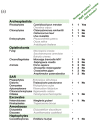A Magnesium Transport Protein Related to Mammalian SLC41 and Bacterial MgtE Contributes to Circadian Timekeeping in a Unicellular Green Alga
- PMID: 30791470
- PMCID: PMC6410215
- DOI: 10.3390/genes10020158
A Magnesium Transport Protein Related to Mammalian SLC41 and Bacterial MgtE Contributes to Circadian Timekeeping in a Unicellular Green Alga
Abstract
Circadian clocks in eukaryotes involve both transcriptional-translational feedback loops, post-translational regulation, and metabolic, non-transcriptional oscillations. We recently identified the involvement of circadian oscillations in the intracellular concentrations of magnesium ions (Mg2+i) that were conserved in three eukaryotic kingdoms. Mg2+i in turn contributes to transcriptional clock properties of period and amplitude, and can function as a zeitgeber to define phase. However, the mechanism-or mechanisms-responsible for the generation of Mg2+i oscillations, and whether these are functionally conserved across taxonomic groups, remain elusive. We employed the cellular clock model Ostreococcustauri to provide a first study of an MgtE domain-containing protein in the green lineage. OtMgtE shares homology with the mammalian SLC41A1 magnesium/sodium antiporter, which has previously been implicated in maintaining clock period. Using genetic overexpression, we found that OtMgtE contributes to both timekeeping and daily changes in Mg2+i. However, pharmacological experiments and protein sequence analyses indicated that critical differences exist between OtMgtE and either the ancestral MgtE channel or the mammalian SLC41 antiporters. We concluded that even though MgtE domain-containing proteins are only distantly related, these proteins retain a shared role in contributing to cellular timekeeping and the regulation of Mg2+i.
Keywords: Ostreococcus tauri; cellular rhythms; circadian clocks; magnesium transport; transporter proteins.
Conflict of interest statement
The authors declare no conflict of interest.
Figures







Similar articles
-
Circadian rhythms persist without transcription in a eukaryote.Nature. 2011 Jan 27;469(7331):554-8. doi: 10.1038/nature09654. Nature. 2011. PMID: 21270895 Free PMC article.
-
Functional analysis of Casein Kinase 1 in a minimal circadian system.PLoS One. 2013 Jul 25;8(7):e70021. doi: 10.1371/journal.pone.0070021. Print 2013. PLoS One. 2013. PMID: 23936135 Free PMC article.
-
The B. subtilis MgtE magnesium transporter can functionally compensate TRPM7-deficiency in vertebrate B-cells.PLoS One. 2012;7(9):e44452. doi: 10.1371/journal.pone.0044452. Epub 2012 Sep 6. PLoS One. 2012. PMID: 22970223 Free PMC article.
-
The unique nature of mg2+ channels.Physiology (Bethesda). 2008 Oct;23:275-85. doi: 10.1152/physiol.00019.2008. Physiology (Bethesda). 2008. PMID: 18927203 Free PMC article. Review.
-
Magnesium transporters: properties, regulation and structure.Front Biosci. 2006 Sep 1;11:3149-63. doi: 10.2741/2039. Front Biosci. 2006. PMID: 16720382 Review.
Cited by
-
Homologs of Ancestral CNNM Proteins Affect Magnesium Homeostasis and Circadian Rhythmicity in a Model Eukaryotic Cell.Int J Mol Sci. 2023 Jan 23;24(3):2273. doi: 10.3390/ijms24032273. Int J Mol Sci. 2023. PMID: 36768595 Free PMC article.
-
SLC41A3 Exhibits as a Carcinoma Biomarker and Promoter in Liver Hepatocellular Carcinoma.Comput Math Methods Med. 2021 Nov 15;2021:8556888. doi: 10.1155/2021/8556888. eCollection 2021. Comput Math Methods Med. 2021. PMID: 34819993 Free PMC article.
-
Deep-coverage spatiotemporal proteome of the picoeukaryote Ostreococcus tauri reveals differential effects of environmental and endogenous 24-hour rhythms.Commun Biol. 2021 Sep 30;4(1):1147. doi: 10.1038/s42003-021-02680-3. Commun Biol. 2021. PMID: 34593975 Free PMC article.
-
Abundant clock proteins point to missing molecular regulation in the plant circadian clock.Mol Syst Biol. 2025 Apr;21(4):361-389. doi: 10.1038/s44320-025-00086-5. Epub 2025 Feb 20. Mol Syst Biol. 2025. PMID: 39979593 Free PMC article.
-
Biological Fluid Flows: Signaling Mediums for Circadian Timing.J Biol Rhythms. 2025 Jun;40(3):234-248. doi: 10.1177/07487304251323318. Epub 2025 Mar 27. J Biol Rhythms. 2025. PMID: 40145493 Free PMC article. Review.
References
Publication types
MeSH terms
Substances
Grants and funding
LinkOut - more resources
Full Text Sources

